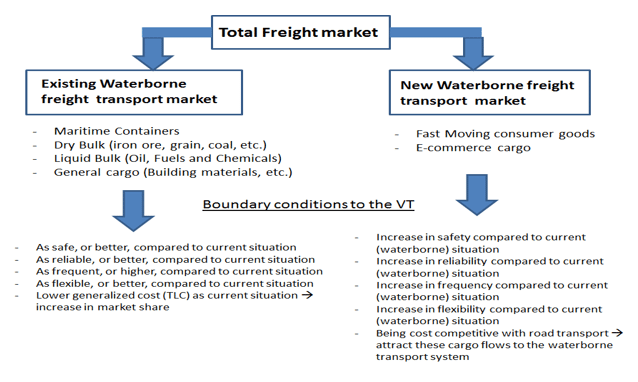VESSEL TRAIN (VT) TYPES
From a conceptual point of view it is possible to create different compositions of Vessel Train’s (VTs) as the navigation and control system will be designed to accommodate any type of vessel. However, in practice a mix of vessel types into a single VT does not seem to be a realistic option. This is mainly due to the different technical characteristics of vessels designed for the markets in which they are operated.
First of all, there is the geographical distinction between the VTs for short sea shipping and the ones to be operated on the inland waterways. Sea-river vessels offer the opportunity to operate both in VTs for shortsea shipping and IWT. Besides this geographical distinction, there is also a difference in cargo type market in which vessels are operated in. For instance, Roll on Roll off (RoRo) and feeder vessels, which are bound to a fixed sailing schedule, will have a much higher operational speed than a coaster, which is sailing in the tramp market. Therefore, the following types of VT will be considered in NOVIMAR:
- Short sea VT:
- RoRo and short sea container VTs (high speed/displacement ratio)
- Multipurpose coasters and Sea River VTs (low speed/displacement ratio)
- Inland VT:
- IWT (large vessels) and Sea river VTs
- IWT (large and small vessels) VTs
Especially the VTs in which small inland vessels can be linked into a VT are an important option to consider. The reason for this is that this type of VT can link these small inland vessels into the VT and bring them to the entrance of a small waterway, from where it can split up from the VT and continue into urban areas.
On top of this, a VT can be formed with existing vessels, equipped with VT technology, but also with newly-built vessels which are dedicatedly designed for a VT.
BUSINESS CONCEPT
An important element to take into account is the business concept of the VT. Conceptually there are three main actors to consider:
- Vessel owner/operator
- VT organizer
- Cargo owner
The vessel owner/operator is the actor who is performing the actual transport on the waterborne transport system. The VT organizer is the actor that will exploit the lead vessel of the VT and bring the different follower vessels together behind the lead vessel. The cargo owner finally is the actor who wants to ship cargo and set the boundary conditions related to the transport (cost, reliability, etc.). This actor is the one that makes the ultimate mode choice.
With respect to the business case of the VT organizer, several options are possible. Firstly, either the VT organizer is a third party that acts as an intermediate operator or it is a shipping company that applies the VT concept to its own fleet. Secondly, given the current structure of the waterborne transport market with a lot of tramp shipping (especially in IWT and the short sea general cargo market), also the distinction between tramp on the one hand and liner shipping (RoRo and short sea container) on the other should be taken into account. Thirdly, there is a possibility of using an existing cargo vessel as a lead vessel or using a dedicated lead vessel. Note: A dedicated lead vessel is a vessel with no cargo carrying capacity and only functions as a waterborne locomotive for a VT.
Based on these criteria, three different business concepts are identified, that will be further researched. These are:
- A dedicated shipping company which will form VTs with own vessels. An own vessel or a dedicated lead vessel can be used as a lead vessel. This could be a viable option for container feeder vessels and RoRo operators where a lot of large shipping companies are active.
- A third party shipping company which will operate dedicated lead vessels which will sail in fixed lines between different ports. This company will sell slots in a vessel train. The follower vessels can make use of this service so that the vessel can be operated with less crew. This option could be viable for the operations on the inland waterways where a lot of small operators (one owner, one vessel) are active.
- An “Uber service”, which will be a very opportunity-driven business model. For this business model, a new entrant could step into the waterborne market via a cloud-based system. Based on a cloud system, vessels can “hook on” a vessel that is a lead vessel – which can be any vessel with the right lead vessel technology. The follower vessel can use that time to have the crew rest – so as to reduce the number of crew members.
FREIGHT MARKET
With respect to the freight market, the following distinction can be made:
- The current-day waterborne transport markets (maritime containers, dry bulk, liquid bulk and general cargo).
- New waterborne markets. These freight markets consist of Fast Moving Consumer Goods (FMCG) and E-commerce cargo.
Both freight markets set different requirements to the VT as can be seen in the next figure.

In order to attract the new cargo types to the waterborne transport system, the VT concept should:
- Increase safety of the cargo compared to the current situation.
- Increase reliability compared to the current situation.
- Increase flexibility compared to the current situation.
- Increase frequency compared to the current situation.
